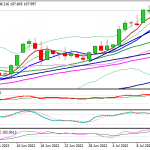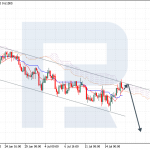(Erste Bank Research Team)
This week is marked by the summertime in the economic calendar, as there are few releases scheduled. The most important development will take place in Poland, as industrial output and retail sales growth figures for June will be released. Thus, Poland will have the full set of data for the second quarter, enabling us to see how the economy performed throughout the first half of the year. The June data will also offer the opportunity to evaluate the upcoming slowdown. Further, unemployment rates will be published in Slovakia and Croatia, and we may see stabilization, as opposed to a seasonal drop of unemployment, as recession fears have been mounting. Finally, PPI indices in Czechia, Poland and Slovenia will be released, allowing us to look for signs of easing inflationary pressure in the months to come.
FX market developments
Global market moves, particularly stronger US dollar and weaker euro (as EUR slid to parity against the USD, driven by concerns that an energy crisis will tip the region into a recession), affected the zloty and the forint – however, the forint later recouped some of those losses. The Czech central bank may have been intervening amidst the summer market liquidity. The zloty ended last week on a weaker footing, close to 4.82 vs. EUR, whereas the koruna and the forint appreciated to 24.49 and 403.9 against the euro, respectively. According to Poland’s central bank Governor Glapinski, the MPC could start cutting interest rates as soon as next year if GDP growth slows down fast. Hungarian central bank raised its key rate by 200bp to 9.75% at a non-rate setting meeting, matching it with its one-week rate. The Hungarian government also announced some new consolidation measures with respect to energy subsidies for households and taxes for small businesses. The EU’s latest rule of law report weighed on the local currencies,as it advises Hungary and Poland to improve judicial and media independence, as well as anti-graft safeguards – conditions to unlock RRF funds. Meeting of the EcoFin Council officially cemented Croatia’s euro adoption from January 1, 2023. It set the conversion rate equal to the ERMII one, at 7.5345 HRK vs. EUR.
Bond market developments
Hungarian government bonds were hit hard last week, with 5Y yields rising 70bp y/y and topping 10%. While yields on LCY bonds also increased on other CEE markets, the move was rather small (10-20bp). The Hungarian government will have a very hot summer during which it will need to seek for a credible solution to get expenditure growth under control and fix the rule of law issues and relationship with EU institutions. In contrast to developments in Hungary, Croatia has set a new role model for other CEE countries when it comes to the deepening of integration. Last week, shortly after the positive decision of the EcoFin on Croatia’s euro adoption, both Fitch and S&P upgraded Croatia’s rating to BBB+, a notch above Hungary. This Friday, Fitch is scheduled to publish its assessment of Hungary, in which a change of the outlook to negative cannot be ruled out.
Read Three important events will mark the European trading week [Video]






























